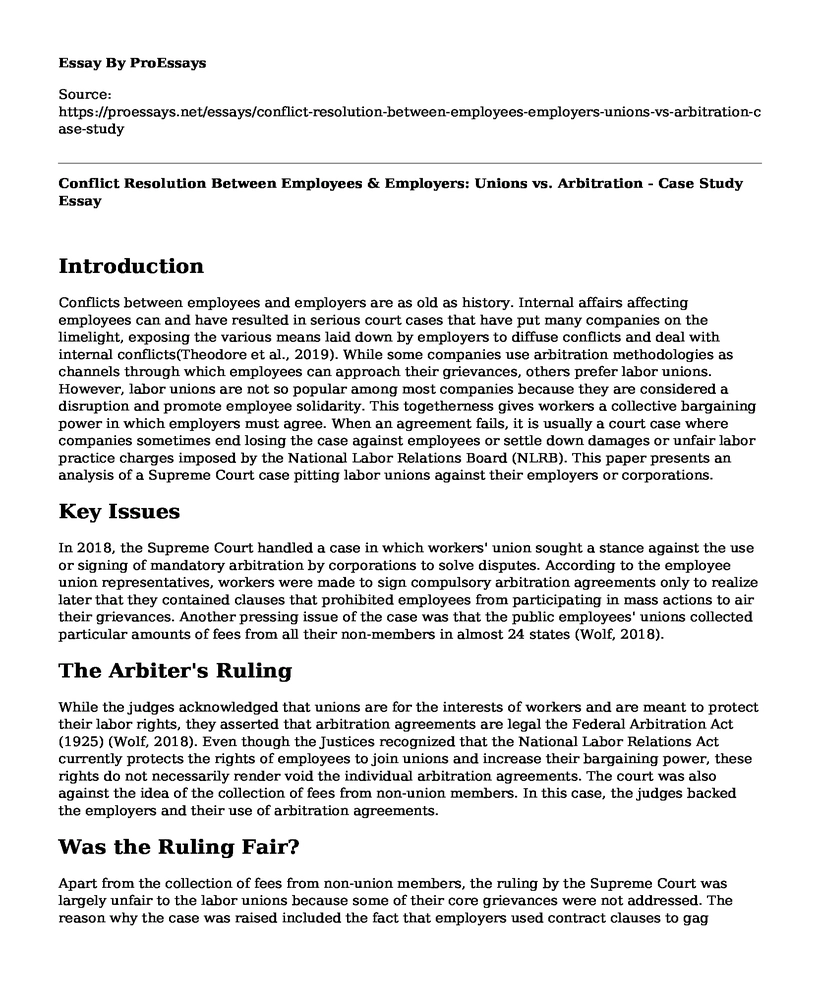Introduction
Conflicts between employees and employers are as old as history. Internal affairs affecting employees can and have resulted in serious court cases that have put many companies on the limelight, exposing the various means laid down by employers to diffuse conflicts and deal with internal conflicts(Theodore et al., 2019). While some companies use arbitration methodologies as channels through which employees can approach their grievances, others prefer labor unions. However, labor unions are not so popular among most companies because they are considered a disruption and promote employee solidarity. This togetherness gives workers a collective bargaining power in which employers must agree. When an agreement fails, it is usually a court case where companies sometimes end losing the case against employees or settle down damages or unfair labor practice charges imposed by the National Labor Relations Board (NLRB). This paper presents an analysis of a Supreme Court case pitting labor unions against their employers or corporations.
Key Issues
In 2018, the Supreme Court handled a case in which workers' union sought a stance against the use or signing of mandatory arbitration by corporations to solve disputes. According to the employee union representatives, workers were made to sign compulsory arbitration agreements only to realize later that they contained clauses that prohibited employees from participating in mass actions to air their grievances. Another pressing issue of the case was that the public employees' unions collected particular amounts of fees from all their non-members in almost 24 states (Wolf, 2018).
The Arbiter's Ruling
While the judges acknowledged that unions are for the interests of workers and are meant to protect their labor rights, they asserted that arbitration agreements are legal the Federal Arbitration Act (1925) (Wolf, 2018). Even though the Justices recognized that the National Labor Relations Act currently protects the rights of employees to join unions and increase their bargaining power, these rights do not necessarily render void the individual arbitration agreements. The court was also against the idea of the collection of fees from non-union members. In this case, the judges backed the employers and their use of arbitration agreements.
Was the Ruling Fair?
Apart from the collection of fees from non-union members, the ruling by the Supreme Court was largely unfair to the labor unions because some of their core grievances were not addressed. The reason why the case was raised included the fact that employers used contract clauses to gag employees against taking collective action which has been supported by labor laws. Membership to any workers' union is labor right that was violated. Forced arbitrations limit the pursuit of justice for vulnerable workers like women especially when companies hire private arbitrators to settle such cases. It is not mentioned whether or not the judges considered looking at the individual elements of the arbitration contract clauses to ensure whether or not certain rights were violated. The same ruling has been witnessed before when the case of Cordua Restaurants, Inc was being heard in 2019 (Theodore et al., 2019).
Ramifications for Both Companies and Unions
In this ruling, the employers had minimal ramifications, and only if they were looked critically. Supporting the employers is typical of the new recommendations by the Trump administration, which is against the position taken earlier by the Obama administration, which supported workers union through the National Labor Relations Board. This ruling pits two federal agencies against each other. For the Workers' Unions, this ruling was a step backward in their fights against violations of their rights by the employers. While the workers should be aware of every content of their contracts, companies should not be too restrictive and exploitative to avoid court cases and labor charges. The use of arbitration agreements has been supported more than once by the courts(Theodore et al., 2019)
Conclusion
To conclude, various elements come into play when companies get involved in tussles with their employees. Most channels of response to employee grievances are not clearcut. Arbitration agreements are used by most companies to subject their employees to certain conditions including not taking part in mass actions. However, when conflicts reach boiling points, they often result in court cases. Conflicts or grievances should not be blocked Clauses in contracts should be explained in detail to the employees before they sign it.
References
Theodore, M., Lebowich, M., Porzio, S., Fox, J., & Franks, L. (2019). NLRB Issues "Epic" Decision Concerning the Intersection of Mandatory Arbitration Agreements and NLRA Section 7 Rights | Labor Relations Update. Labor Relations Update. Retrieved 23 March 2020, from https://www.laborrelationsupdate.com/arbitration/nlrb-issues-epic-decision-concerning-the-intersection-of-mandatory-arbitration-agreements-and-nlra-section-7-rights/.
Wolf, R. (2018). Supreme Court backs employers over workers in first of two major labor cases. Usatoday.com. Retrieved 23 March 2020, from https://www.usatoday.com/story/news/politics/2018/05/21/supreme-court-backs-employers-over-workers/355923002/.
Cite this page
Conflict Resolution Between Employees & Employers: Unions vs. Arbitration - Case Study. (2023, May 01). Retrieved from https://proessays.net/essays/conflict-resolution-between-employees-employers-unions-vs-arbitration-case-study
If you are the original author of this essay and no longer wish to have it published on the ProEssays website, please click below to request its removal:
- Memo to Intelligence Department of Homeland Security - Critical Thinking
- Why Abortion Should Be Legalized Essay Example
- International Criminal Courts: Prosecution of War Crimes, Genocide & Beyond - Essay Sample
- Essay on 1950s United States Civil Rights Movement: Non-Violent Protests & Equal Rights
- Murder: The Most Prevalent Crime in the US - Essay Sample
- Paper Example on Restorative Justice: An Overview of Programs and Benefits
- Free Essay Example: Facebook's Controversial Privacy Policies and Impact on Emotions







